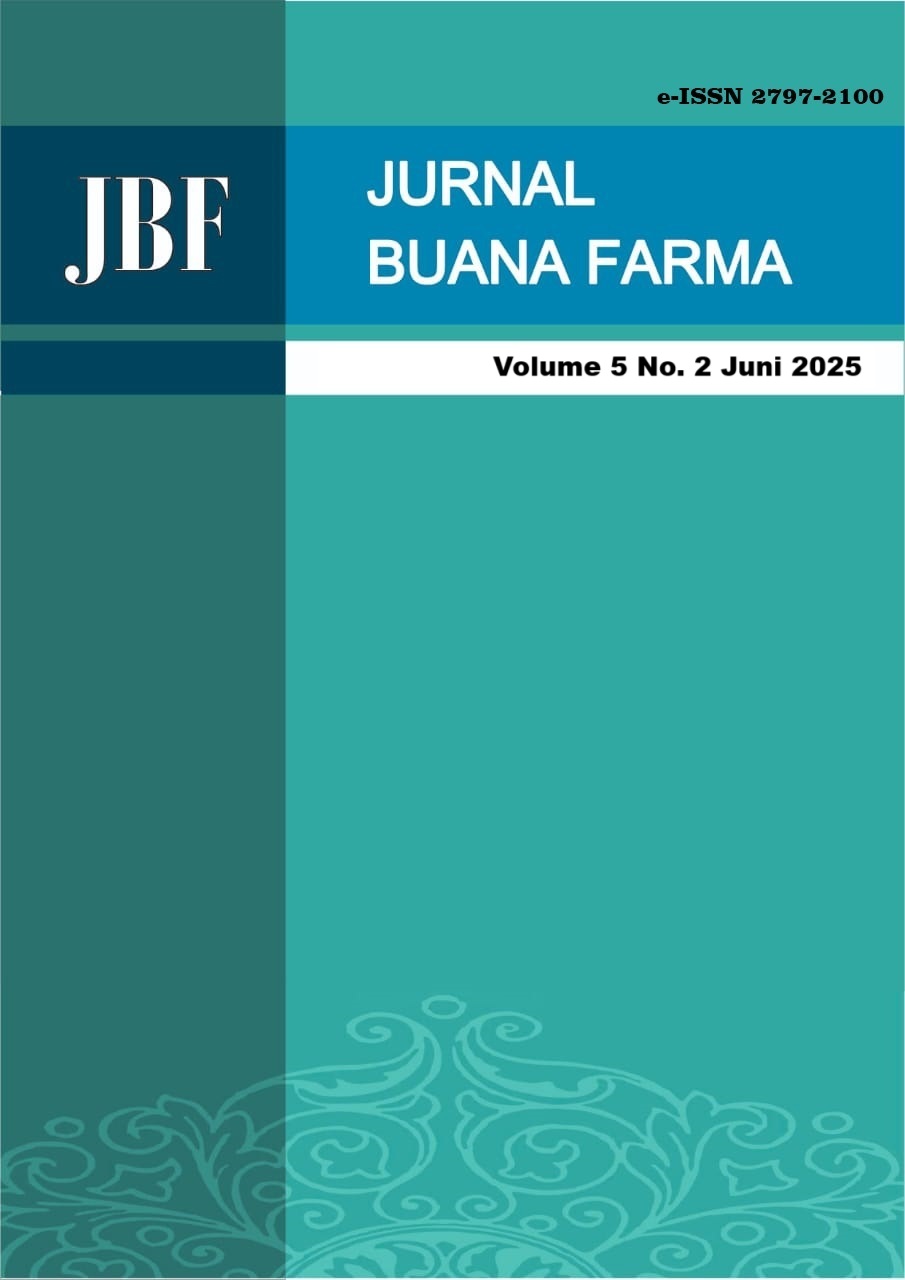UJI KUALITATIF BAHAN PENYUSUN SEDIAAN MIKROSFER BSA DENGAN KITOSAN DAN NA-TPP
Abstrak
Penelitian ini bertujuan untuk mengevaluasi karakteristik secara kualitatif bahan penyusun sistem penghantaran protein berbasis mikrosfer, yaitu Bovine Serum Albumin (BSA), kitosan, natrium tripolifosfat (Na-TPP), dan maltodekstrin, melalui uji organoleptis, Fourier Transform Infrared Spectroscopy (FTIR), dan Differential Thermal Analysis (DTA). Hasil pengamatan menunjukkan bahwa masing-masing bahan memiliki ciri khas yang sesuai dengan data pustaka terbaru, baik secara visual maupun spektrum dan termal. Spektrum FTIR BSA memperlihatkan gugus amida I dan II yang menandakan struktur sekunder protein tetap terjaga. Kitosan menunjukkan gugus fungsional yang memungkinkan interaksi dengan TPP untuk membentuk ikatan silang dalam sistem mikrosfer. Spektrum FTIR TPP menunjukkan keberadaan gugus P=O dan P-O-P yang berperan penting dalam proses gelasi ionik. Maltodekstrin memiliki gugus hidroksil dan karbonil yang menunjukkan perannya sebagai penstabil dalam formulasi. Data DTA menunjukkan bahwa semua bahan memiliki stabilitas termal yang cukup untuk mendukung proses formulasi. Dengan demikian, kombinasi keempat bahan tersebut dinilai kompatibel dan efektif dalam mendukung sistem penghantaran protein berbasis mikrosfer, baik dari sisi struktur kimia maupun stabilitas termalnya.
Referensi
Alhazmi, H. A. (2019). FT-IR Spectroscopy for the Identification of Binding Sites and Measurements of the Binding Interactions of Important Metal Ions with Bovine Serum Albumin. Scientia Pharmaceutica, 87(1), 5.
Das, S., Chaudhury, A., & Mitra, A. (2011). Preparation and evaluation of microcapsules of BSA using natural polysaccharides. International Journal of PharmTech Research, 3(1), 133–141.
Departemen Kesehatan Indonesia. 1995. Farmakope Indonesia. Ed ke 4. Jakarta: Depkes RI.
Departemen Kesehatan RI. 2014. Farmakope Indonesia. Jakarta: Depkes RI.
Gan, Q. and Wang, T. (2007) Chitosan Nanoparticle as Protein Delivery Carrier-Systematic Examination of Fabrication Conditions for Efficient Loading and Release. Colloids and Surfaces Biointerfaces, 59, 24-34.
Han, Y., & Misra, M. (2009). Effects of process parameters on formation of chitosan–TPP microspheres containing BSA. Pharmaceutical Development and Technology, 14(3), 344–352.
Hariningsih Y, Dwi Rahasasti I, Ma’Rif S, Haqoiroh dan Puspitasari, K. (2025). Pengaruh Kombinasi Polimer HPMC dan PVP terhadap Sifat Fisik Sediaan Patch Ekstrak Pelepah Pisang Ambon (Musa paradisiaca var.sapientum L). Journal Of Current Paharmaceutical Sciences, 9(1), 33-41.
Hendradi E, Sari R, Anggai, R. (2019). Preparation and Characterization of BSA-loaded Chitosan Microspheres. Health Nations, 2 (9): 930-934.
Huang Y, Zheng X, Zheng C, Dong S, Liang W. (2010). Alginate–Chitosan–PLGA Composite Microspheres Enabling Single-Shot Hepatitis B Vaccination. The AAPS Journal, 12, 519–524.
Mohapatra, S., Mallick, S., Maiti, S., & Pattnaik, S. (2021). Chitosan-based nanocarriers for protein/peptide delivery. International Journal of Biological Macromolecules, 183, 235–249
Rao, J.P., et al. (2011). Chitosan microspheres as a delivery system for nasal insufflation. International Journal of Pharmaceutics, 411(1-2), 1–9.
Rodrigues, S., da Costa, A.M.R. and Grenha, A. (2012). Chitosan/carrageenan Nanoparticles: Effect of Cross-linking with Tripolyphosphate and Charge Ratios. Carbohydrate Polymers, 89, 292-289.
Rowe, R.C., Paul, J.S., Maria Equinn. (2009). Handbook Of Pharmaceutical Excipient Sixth edition. Pharmaceutical Press: London.
Sun, H., et al. (2013). FTIR and thermal analysis of maltodextrin in microencapsulation applications. Food Hydrocolloids, 31(1), 42–49.













